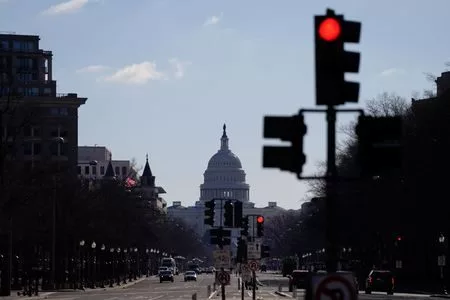By Lucia Mutikani
WASHINGTON (Reuters) – U.S. job growth likely slowed in January, partly restrained by wild fires in California and cold weather across much of the country, though not enough for the Federal Reserve to resume interest rate cuts before the end of the first half.
The Labor Department’s closely watched employment report on Friday will be distorted by annual benchmark revisions, new population weights as well as updates to the seasonal adjustment factors, the model the government uses to strip out seasonal fluctuations from the data.
Nonetheless, economists expect the healthy labor market narrative to remain intact. The unemployment rate is forecast at 4.1% amid historically low layoffs, with wages rising solidly.
Labor market resilience is the driving force behind the economic expansion and has given the U.S. central bank room to pause rate cuts while policymakers assess the impact of the fiscal, trade and immigration policies of President Donald Trump’s administration, deemed by economists as inflationary.
“There will be some noise, but the general message is going to be a continuation of a relatively healthy labor market,” said Dan North, senior economist at Allianz Trade Americas. “There’s no reason to derail that narrative.”
The survey of establishments is likely to show nonfarm payrolls increased by 170,000 jobs last month after surging 256,000 in December, a Reuters poll of economists showed.
Wildfires in Los Angeles are estimated to have subtracted as many as 25,000 jobs from payrolls, with most of the hit expected in accommodation and food services as well as the housekeeping sector. Frigid temperatures and snow storms that blanketed large swathes of the country likely halted work at construction sites and impacted other parts of the leisure and hospitality industry, potentially cutting off another 15,000 jobs.
The final employment report under former President Joe Biden’s administration is expected to show slower job growth from April 2023 through March 2024 than had been reported. The government estimated in August that the level of employment over the 12-month period would be lowered by 818,000 jobs. Subsequent updates to the source data, however, led economists to expect that the reduction would amount to 675,000-700,000 jobs.
DOWNWARD REVISIONS
The payrolls count from April to December is also likely to be revised to reflect new seasonal factors and information. The benchmark revision will also affect average hourly earnings and the workweek. Average hourly earnings were forecast rising 0.3%, matching December’s gain. That would lower the annual increase in wages to a still-solid 3.8% from 3.9% in December.
“We expect the annual revision will reduce the recent trend pace of growth by 35,000, and by about 70,000 on average over the April 2023-March 2024 period,” said Andrew Husby, a senior U.S. economist at BNP Paribas Securities. “A larger effect on recent momentum is possible, but we are skeptical given robust economic growth.”
With job growth increasingly concentrated in low-paying industries, like leisure and hospitality as well as healthcare and social assistance, some economists said that the labor market was masking a white collar recession they believed was underway. They argued that the Fed should be cutting rates.
“Jobs in the middle and higher end of the income spectrum, many of them are gone,” said Sung Won Sohn, Finance and Economics professor at Loyola Marymount University. “Maybe the economy is not as strong as one would think, simply based on the monthly payroll numbers. I hope the Fed takes that into consideration.”
The U.S. central bank left its benchmark overnight interest rate unchanged in the 4.25%-4.50% range last month, having reduced it by 100 basis points since September, when it embarked on its policy easing cycle. The policy rate was hiked by 5.25 percentage points in 2022 and 2023 to tame inflation.
Financial markets are expecting a rate cut in June.
There are growing concerns that mass deportations and tariffs could hamper the labor market this year, by reducing labor supply and making businesses reluctant to add to their costs by expanding headcount. Moves by the Trump administration to slash federal government jobs were also seen curbing employment growth. Government employment, including state and local government, has been a major contributor to job growth.
January’s employment report will also include new population controls for the household survey from which the unemployment rate is derived. The new weights are likely to increase the size of the labor force and boost household employment, which would narrow the gap with nonfarm payrolls. Economists had argued that the household survey was not capturing the surge in immigration, accounting for the disconnect with the establishment survey.
The unemployment rate has typically not been affected by the population controls, but January’s rate will not be directly comparable to December because of the break in the series.
“The underlying pace of job growth is currently around 150,000 and, if anything, should moderate further in early 2025, reflecting both easing in the demand for workers as the economy slows a bit and a reduction in the rate of increase in labor supply as well given tighter immigration policy,” said Stephen Stanley, chief U.S. economist at Santander U.S. Capital Markets.
“Businesses would take a conservative approach to investing and hiring in early 2025 in light of the immense policy-related uncertainty that firms face in the short run.”
(Reporting by Lucia Mutikani; Editing by Andrea Ricci)
Brought to you by www.srnnews.com








